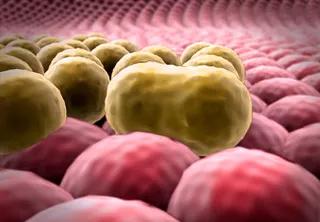Inhibiting the gene could slow the obesity epidemic

Research from the laboratory of Paul Fox, PhD, Department of Cellular and Molecular Medicine, showed for the first time that inhibiting the enzyme glutamyl-prolyl tRNA synthetase (EPRS) reduces obesity and extends the lifespan of mice, even when fed a high-fat diet.
Advertisement
Cleveland Clinic is a non-profit academic medical center. Advertising on our site helps support our mission. We do not endorse non-Cleveland Clinic products or services. Policy
“For the first time in human history, obesity is a bigger problem in the world than undernourishment, and it’s affecting our health and lifespan. We are excited about this new connection that provides a potential target for treatments to combat obesity and aging,” says Dr. Fox.
This landmark research is published in the journal Nature.
A tRNA synthetase, EPRS plays a central role in interpreting the genetic code. But EPRS, like many proteins, has a secondary function. The Fox team predicted EPRS would play a role in inflammation, but when they prevented its activation through the process of phosphorylation, something quite unexpected was seen. They created a mouse that expressed the EPRS gene, but with a substitution of one amino acid, which prevented phosphorylation from occurring. Surprisingly, the result was a slender, healthy mouse.
“The mouse was skinny, but perfectly normal — even better than normal, because it remained lean on a high-fat diet,” says Dr. Fox.
Moreover, the mouse lived about four months longer than control mice whose EPRS gene was unaltered. In human terms, this benefit would raise the median lifespan from about 77 to 88 years.
Dr. Fox thinks EPRS may be one of the genes implicated in the “Thrifty Gene Hypothesis.” This hypothesis postulates that we get fat, not only because we eat too much and exercise too little, but because our bodies have evolved a mechanism to hoard calories for times of famine.
“Centuries ago, there were cycles of food and famine. We don’t have those cycles any more. We eat all the time, and we still store those calories,” he explains.
Advertisement
Now that the secondary role of EPRS is understood, the Fox laboratory plans to work on developing an inhibitor to block its activation. Such a drug could prove to be the long-sought fountain of youth and good health.
“If we can do this successfully, people would not become obese, because their glucose and carbohydrate metabolism would be better, and they would live 10 years longer,” says Dr. Fox.
But before they go too far, the researchers plan to make sure the skinny mice get a clean bill of mental, as well as physical, health.
“The mice look normal, breed normally, their hearts and livers function well and they are very active. But before we invest time and money in developing an inhibitor, we may do some memory and intelligence testing on them,” says Dr. Fox.
In addition to staying svelte and living longer, eliminating obesity might prevent the development of certain diseases. One of these is breast cancer, which has a strong connection to obesity in postmenopausal women.
Since mice are susceptible to mammary tumorigenesis when fed a high-fat diet, they provide an ideal model for studying whether eliminating obesity might lower the risk of breast cancer in humans. The Fox lab plans to test whether mice with the genetic mutation that prevents obesity are resistant to breast cancer. Colon cancer and brain tumors are also on their hit list, as is cardiovascular disease.
It seems ironic that long-lived, skinny mice just might hold the key to preventing or reducing some of the world’s most common causes of mortality. Dr. Fox calls the relationship of EPRS to disease “the tip of the iceberg.”
Advertisement
“We don’t yet know how big the iceberg is, or how deep it goes, but we plan to explore it in detail,” he says.
Advertisement
Advertisement

First full characterization of kidney microbiome unlocks potential to prevent kidney stones

Researchers identify potential path to retaining chemo sensitivity

Large-scale joint study links elevated TMAO blood levels and chronic kidney disease risk over time

Investigators are developing a deep learning model to predict health outcomes in ICUs.

Preclinical work promises large-scale data with minimal bias to inform development of clinical tests

Cleveland Clinic researchers pursue answers on basic science and clinical fronts

Study suggests sex-specific pathways show potential for sex-specific therapeutic approaches

Cleveland Clinic launches Quantum Innovation Catalyzer Program to help start-up companies access advanced research technology